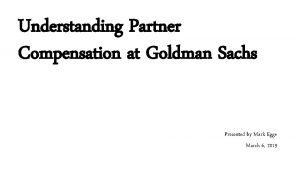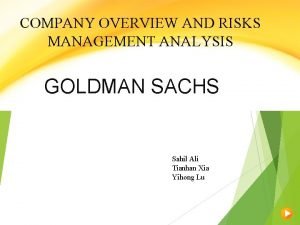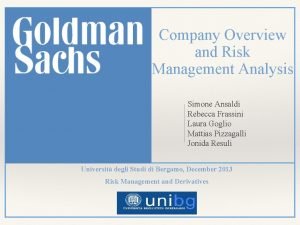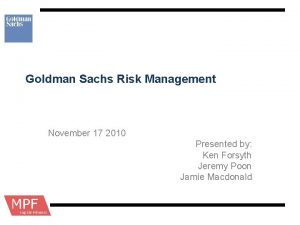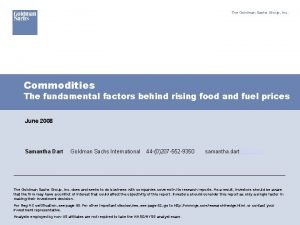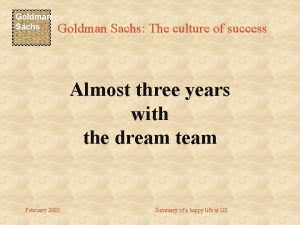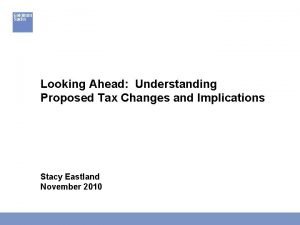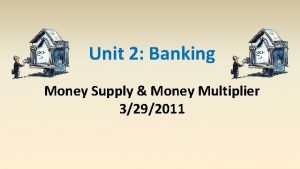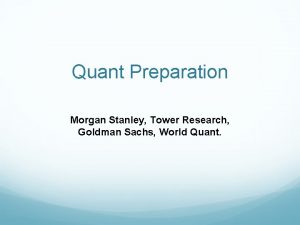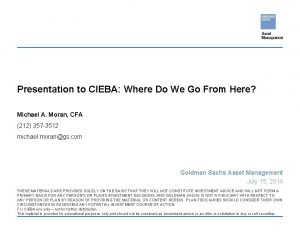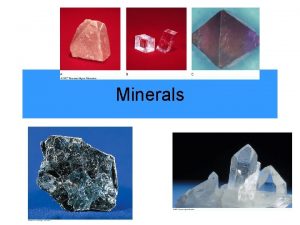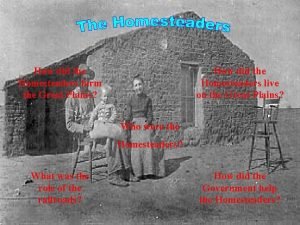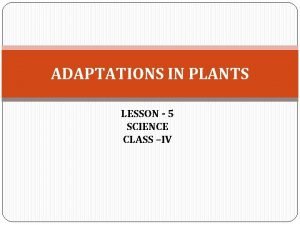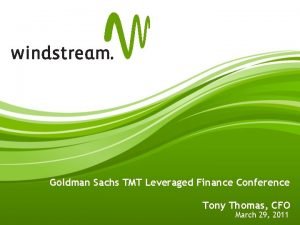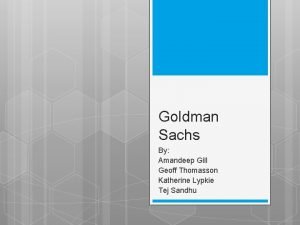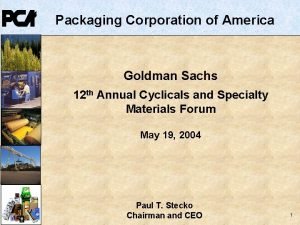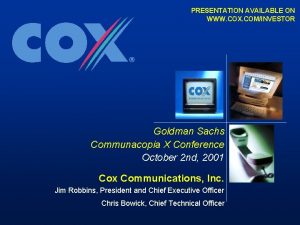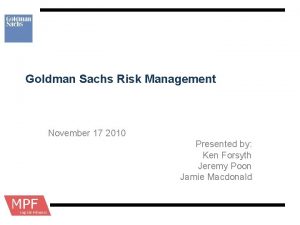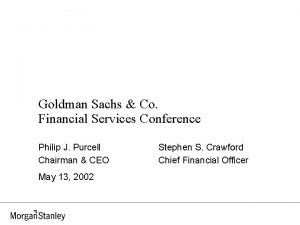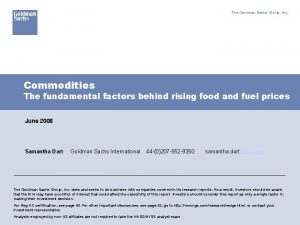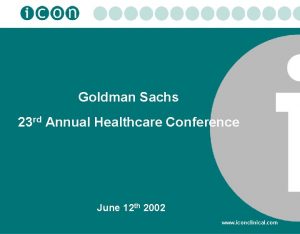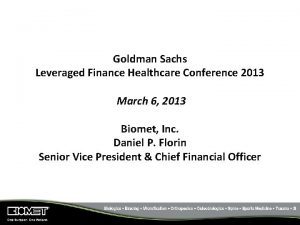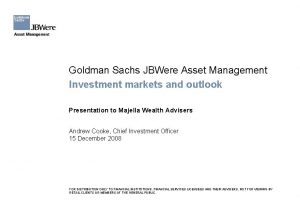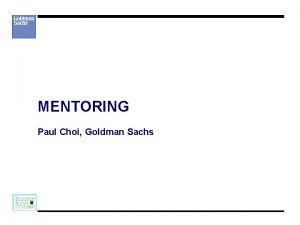1 Goldman Sachs Can the World Survive the





































- Slides: 37

1 Goldman Sachs Can the World Survive the US Downturn? Gavyn Davies Chief International Economist Enron Advisory Council Houston 11 th April 2001

2 Main Topics Models to estimate the statistical probability of recession. The economic cycle and financial market risk premia - the importance of leading indicators. Goldman Sachs “main case” forecast for GDP. Downside risks - ICT spending; US domestic demand; oil. The downside case for economic activity. Interest rates for currencies.

3 Probability of Recession Model February Observation Coefficient T-Statistic Rank 1 Indicator Univ. of Michigan Consumer Sentiment - 16. 70 - 0. 0610 - 2. 79 2 Consumer Price Index - Energy 12. 88 0. 027 1. 59 7 Inventory / Shipment Ratio - Mfg. 0. 07 4. 037 2. 56 3 Ratio of Unsold to Sold Homes 0. 34 8. 266 5. 46 6 - 0. 39 - 0. 869 - 5. 65 1 Real M 2 1. 30 0. 264 2. 17 4 Corporate Yield Spread 0. 77 0. 83 2. 13 5 10 -Year / Fed Funds Spread 1 Importance in recent rise in probability of recession. Source: Our Calculations.

4 US: Probability of Recession 1. 2 Probability of recession* 1. 0 0. 8 0. 6 0. 4 0. 2 0. 0 68 70 72 74 76 78 80 82 84 86 88 90 92 94 96 98 00 Probability of recession starting within the following 12 months based upon a probit model using 7 real and financial indicators.

5 1. 2 Probability of Recession: OECD ex. USA* 1. 0 0. 8 0. 6 0. 4 0. 2 0. 0 71 73 75 77 79 81 83 85 87 89 91 93 95 97 99 01 *Probability of a recession occurring within the following 12 months. Shaded regions indicate actual periods of recession.

6 Euroland GDP Growth Probabilities One Year Ahead 110 % 100 90 80 70 60 50 40 30 <0% 20 10 0 92 93 <2% 94 95 96 97 98 99 00 01

7 Japan: Probability of Recession* 100 90 % 80 70 60 50 40 30 20 10 0 83 84 85 86 87 88 89 90 91 92 93 94 95 96 97 98 99 00 01 * Probability of the economy entering a recession over the next 12 months.

8 UK: Probability of Recession* 90 80 70 % Economy In Recession 60 50 40 30 20 10 0 86 87 88 89 90 91 92 93 94 95 96 97 98 99 00 01 02 *Probability of negative annual GDP growth in one year's time.

9 Relative Performance of World Equities vs Bonds & OECD Leading Indicator 40 30 20 % yoy OECD Leading Indicator 12 10 8 6 10 4 0 2 -10 0 -2 -20 -30 -4 World Equity Returns minus Bond Returns in US$ -6 -8 -40 88 89 90 91 92 93 94 95 96 97 98 99 00 01 02

10 OECD Leading Indicator and World 10 Equity Risk Premium % yoy %, 3 m Mov. Av 8 6 OECD LI 0 0. 5 1 4 1. 5 2 2 0 2. 5 -2 -4 World ERP (inverted) 3 3. 5 -6 4 90 91 92 93 94 95 96 97 98 99 00 01 02

11 OECD Leading Indicator and US Corporate Bond Spread 12 10 8 6 % yoy US Baa Corporate Bond Spread (inverted) %, 3 m Mov. Av. 0 0. 5 1 1. 5 4 2 2 0 2. 5 3 -2 3. 5 -4 -6 -8 OECD LI 4 4. 5 5 80 81 82 83 84 85 86 87 88 89 90 91 92 93 94 95 96 97 98 99 00 01 02

12 Relative Performance of Emerging Market vs World Equities & OECD Leading Indicator 80 % yoy 60 40 % yoy Emerging Market minus World Equity Returns in US$ 12 10 8 6 20 4 0 2 -20 0 -2 -40 -60 -80 86 -4 OECD Leading Indicator 88 90 92 94 96 -6 98 00 -8 02

13 Lead/lag of OECD Leading Indicators at Turning Points Turning Point in OECD LI Lead in months over. . . TYPE Date OECD Ind. Prodn Peak Jan-00 4 8 1 1 Trough Oct-98 6 -2 1 0 Peak Sep-97 4 0 -4 8 Trough Jun-96 -2 - 14 -5 -7 Peak Jan-95 7 - 12 0 -3 Trough Oct-92 9 4 6 2 Peak Jan-89 3 — 4. 4 - 2. 7 0. 3 0. 2 Average Emg. Mkt. US Corp. World Equity Bond Sprd. Spread Risk Premium

14 Correlation between OECD Leading Indicators & Other Variables Correlation with Leading Indicators x months ahead* Variable -6 -4 -2 0 +2 +4 +6 US Corp. Spread 0. 45 0. 48 0. 50 0. 47 0. 35 0. 20 0. 05 Emg. Mkt. Bond Spread -0. 09 0. 04 0. 15 0. 26 0. 25 0. 17 0. 10 World Equity Risk Premium 0. 04 0. 13 0. 21 0. 24 0. 19 0. 07 -0. 05 US Equity Risk Premium -0. 03 0. 04 0. 12 0. 17 0. 18 0. 16 -9 -8 -7 -6 -5 -4 -3 0. 854 0. 849 Months OECD Ind. Prod. 0. 838 0. 847 OECD GDP 0. 726 — — 0. 809 — — 0. 749 -4 -3 -2 -1 0 +1 +2 0. 893 0. 891 0. 887 Months GS LI 0. 888 0. 891 * Month of highest correlation in bold. 0. 835 0. 811 0. 873 0. 855

15 Turning Points in “OECD” Longer Leading Indicator and Other Indicators Turning Point . Lead of “OECD” LLI in months over. . . OECD LI OECD IP Jun-99 7 11 Trough May-98 5 11 Peak Feb-97 7 11 Trough Dec-95 6 4 Peak Oct-94 3 10 Trough Oct-92 0 9 Peak Aug-87 Average 17 6. 4 20 10. 9 TYPE “OECD” LLI Trough Dec-00 Peak

16 1. 15 1. 10 Leading Indicators of OECD Economic Activity Ratio to trend "Longer" Leading Indicator ("OECD" LLI)* 1. 05 f'cst values 1. 00 0. 95 OECD's Leading Indicator *Constructed from the components of the OECD's indicator that have historically had a long lead on economic activity at turning points. 0. 90 87 88 89 90 91 92 93 94 95 96 97 98 99 00 01 02

17 1. 15 1. 10 1. 05 Leading Indicators of OECD Economic Activity Ratio to trend OECD's Leading Indicator GS Leading Indicator (GS LI)* 1. 00 0. 95 *Based on an econometric model to predict changes in the OECD's indicator. f'cst values 0. 90 87 88 89 90 91 92 93 94 95 96 97 98 99 00 01 02

18 12 11 10 9 8 7 6 5 4 3 2 1 0 -1 -2 -3 -4 Main Six Economies % yoy Leading Indicator 16 12 8 4 0 -4 Industrial Production 71 73 75 77 79 81 83 85 87 89 91 93 95 97 99 01 -8 -12

19 Global GDP Forecasts % Change on Year Earlier 1999 2000 2001 (f) 2002 (f) USA 4. 2 5. 0 1. 4 2. 5 Euroland 2. 5 3. 4 2. 7 Japan 0. 8 1. 7 1. 5 1. 4 OECD Total 3. 0 3. 7 1. 8 2. 5 Non Japan Asia 6. 5 7. 2 5. 1 5. 8 Latin America 0. 0 4. 2 3. 4 4. 3 Emerging C. Europe 3. 1 4. 0 3. 7 4. 2 Emerging World 4. 2 6. 1 4. 6 5. 3 World 3. 5 4. 6 2. 7 3. 4

20 3 Estimates of G 6 Output Gap % yoy 2 Goldman Sachs 1 0 -1 -2 OECD IMF -3 -4 -5 80 82 84 86 88 90 92 94 96 98 00 02

21 3. 0 OECD Headline & Core Inflation % yoy 2. 5 Headline CPI 2. 0 Core CPI 1. 5 1. 0 96 97 98 99 00 01 02 03

22 US Hardware & Communications Equipment Spending 50 % yoy 40 30 Orders, 3 mma Investment Spending 20 10 0 -10 80 82 84 86 88 90 92 94 96 98 00 02

23 ICT Spending Projections 1 ICT Spending (% Growth) 1999 2000 F 2001 F Hit to GDP 2 (% pts) 2001 F US Japan 15. 4 5. 1 22. 9 20. 1 - 2. 4 10. 6 - 1. 0 - 0. 5 Germany France UK G 5 6. 4 16. 2 4. 0 11. 6 9. 6 24. 1 6. 0 19. 6 4. 3 10. 8 2. 7 2. 3 - 0. 1 - 0. 4 - 0. 1 - 0. 7 1 Assuming level of orders remains unchanged at average level between Dec '00 and Jan '01 throughout 2001. 2 Direct impact on nominal spending. Total impact on real GDP will be higher.

24 86 Oil Price Forecast US$/bl (Million Barrels) 84 WTI 35 30 82 25 80 78 Global demand 20 76 15 74 72 99 Global supply 00 Forecast 01 10 02

25 Impact of Oil Price Change on Terms-of-Trade Terms-of-trade or balance of payments loss* % of GDP 1973 -74 1978 -80 1989 -91 1998 -01 US 1. 0 2. 5 0. 6 Euroland 2. 6 3. 7 0. 9 0. 8 Japan 3. 0 3. 8 0. 8 1. 0 OECD 1. 9 3. 2 0. 7 * Negative figure indicates a terms-of-trade gain. The terms-of-trade loss is calculated by multiplying the percentage increase in the dollar price of oil by the share of oil and gas imports in GDP. We assume the price of brent oil rises from $13. 1 bbl in 1998 to $26. 5 bbl in 2001.

26 US Real Financial Conditions Index 100 99. 5 99 Tighter 98. 5 98 97. 5 97 96. 5 96 95. 5 95 94 Easier 95 96 97 98 99 00 01 02

27 14 US Saving Rate at Record Low % Ratio, inverted Net Worth/Disposable Income Ratio 12 4. 5 10 8 Q 1 estimate 6 5. 0 5. 5 Household Saving Rate 4 4. 0 2 6. 0 0 -2 80 82 84 86 88 90 92 94 96 98 00 6. 5 02

28 US Personal Saving Rate (% of Disposable Income) Change, Predicted Change, Actual (wealth stays flat) (wealth rises 5%) (wealth rises 10%) 00 Q 1 - 1. 3 - 1. 1 00 Q 2 + 0. 1 - 0. 8 00 Q 3 - 0. 5 + 0. 5 00 Q 4 - 0. 6 + 0. 1 01 Q 1 + 0. 9 01 Q 2 + 0. 9 + 0. 7 + 0. 5 01 Q 3 + 0. 8 + 0. 5 + 0. 1 01 Q 4 + 0. 9 + 0. 5 + 0. 1 Source: Department of Commerce. Our Calculations.

US: A Stable Capital Stock Share = Collapse in ICT Investment 29 8 % of GDP 13 12 11 6 10 4 9 ICT Capital Stock 8 2 0 90 ICT Business Fixed Investment Assuming 1990 -99 Growth* Assuming No Growth** 91 92 99 94 95 96 97 7 6 98 99 00 5 01

30 US - Financial Balances 8 7 % of GDP 6 5 Private Sector 4 Balance 3 2 1 0 -1 Current Account -2 -3 -4 -5 -6 -7 -8 83 85 87 89 91 Fiscal Balance 93 95 97 99 01 03

31 Impact on GDP of Possible Global Shocks in 2001 Impact on GDP % of GDP Direct Hit From US Gain from Collapse in Recession Collapse in Tech Total GDP Via Exports 1 Oil Prices 2 Spending 3 Effect US - 2. 0 0. 5 - 0. 8 - 2. 3 Japan - 0. 2 0. 7 - 0. 5 0. 0 Euroland - 0. 1 0. 6 - 0. 2 Main OECD Countries - 0. 8 0. 5 - 0. 8 This column shows the direct trade hit from a decline of 6% in exports to the US. This would likely happen if US domestic demand dropped by 3% in 2001 (relative to our main case forecast). The drop in US GDP would be around 2%. 1 This assumes average oil prices in 2001 drop by $10/barrel compared with our main case assumption of $22/barrel. 2 This assumes a drop in ICT investment in line with recent orders data. US tech spending decelerates from 22% growth in 2000 to 1% in 2001. 3

32 Euroland: Industrial Production 10 % Yo. Y Simulations 8 GS Leading Indicator 6 4 Industrial Production (Yo. Y Chg) 2 0 -2 97 98 99 00 01 02

33 Japan - Financial Balances 12 % of GDP 10 8 6 4 2 0 -2 -4 -6 -8 -10 83 85 87 Private Sector Balance Current Account Fiscal Balance 89 91 93 95 97 99 01 03

34 Outlook for 2001: Central Case & Downside Scenario GDP - annual average % Change CPI - yoy, end-year Central Case Downside Scenario US 1. 4 -0. 6 2. 4 1. 1 Japan 1. 5 0. 8 -0. 1 -0. 2 Euroland 2. 4 1. 7 1. 4 1. 0 UK 2. 2 1. 6 1. 5 1. 2 OECD 1. 8 0. 6 1. 6 0. 9 OECD ex US 2. 1 1. 5 1. 0 0. 7

35 G 7: GSWIRE Scenarios % GS Forecasts Baseline Actual/Forwards Boom Bust

36 Euro / US$ EXCEL LINKED +1 Standard Error Spot GSDEER -1 Standard Error 02

37 US: BAA Corporate Bond Spread* % Actual *Moody’s Baa-30 year Treasury GS-Spread** Projections **Out of Sample
 Goldman sachs partner compensation
Goldman sachs partner compensation Goldman sachs veterans
Goldman sachs veterans Goldman sachs darkpool
Goldman sachs darkpool Goldman sachs risk management framework
Goldman sachs risk management framework Goldman sachs organizational structure
Goldman sachs organizational structure Goldman sachs icon
Goldman sachs icon Credit risk management and advisory goldman sachs
Credit risk management and advisory goldman sachs Goldman sachs
Goldman sachs Goldman sachs culture of success
Goldman sachs culture of success Stacy eastland goldman sachs
Stacy eastland goldman sachs Goldman sachs
Goldman sachs Goldman sachs mask
Goldman sachs mask Money multiplier
Money multiplier Goldman sachs puzzles
Goldman sachs puzzles Sean brennan goldman sachs
Sean brennan goldman sachs Goldman sachs 10 000 small businesses requirements
Goldman sachs 10 000 small businesses requirements Goldman sachs case competition
Goldman sachs case competition High force waterfall
High force waterfall Madeline astor
Madeline astor How do adaptations help animals survive
How do adaptations help animals survive What does cole do to survive in chapter 11
What does cole do to survive in chapter 11 Mmacam
Mmacam Only the paranoid survive summary
Only the paranoid survive summary Survive
Survive Organisms changed because they wanted to survive
Organisms changed because they wanted to survive How to survive nnn
How to survive nnn Survive asl
Survive asl Minerals vs elements
Minerals vs elements How did homesteaders survive on the plains
How did homesteaders survive on the plains Survive lt
Survive lt Survive and thrive in times of change
Survive and thrive in times of change Cnidocytes help a cnidarian survive by
Cnidocytes help a cnidarian survive by What is adaptation in science for class 4th
What is adaptation in science for class 4th Will optometry survive
Will optometry survive Survive and protect the endangered plants
Survive and protect the endangered plants Home sweet home survive prayer
Home sweet home survive prayer Amoeba euglena paramecium
Amoeba euglena paramecium Adj
Adj
